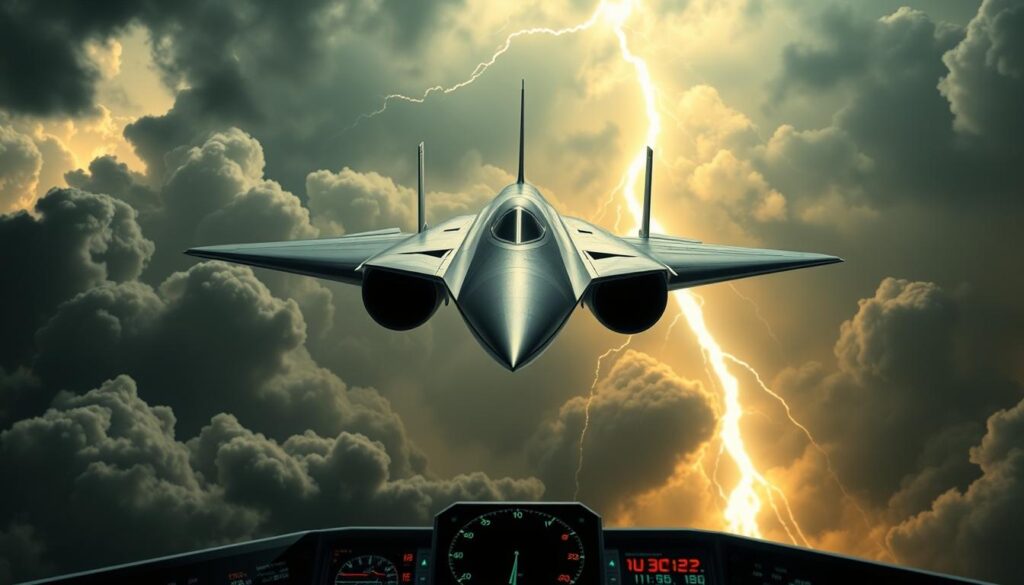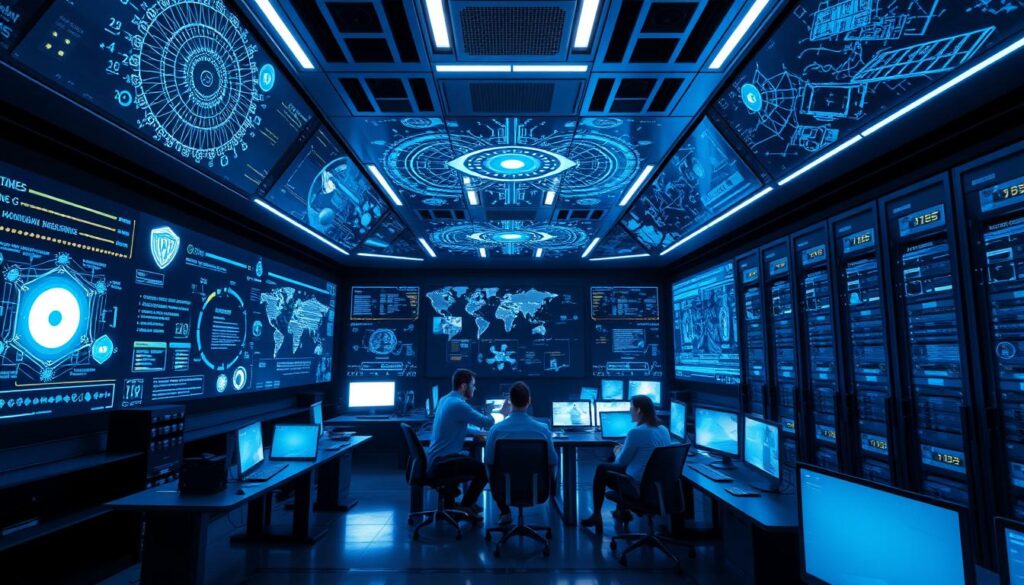For centuries, technology has changed warfare a lot. From the Industrial Revolution’s mass-produced weapons to today’s ai military systems. Now, drones patrol skies and algorithms guide strikes. A big question is: Where do we draw the line between technology warfare advancements and ethical responsibility?
History shows that innovation often moves faster than morality. Radar changed the game in WWII, and Ukraine now relies on drones. Yet, with autonomous weapons systems being debated, countries struggle to find a balance between progress and principle.
Key Takeaways
- Historic tech milestones like nuclear arms and drones highlight rapid military evolution.
- Modern ai military systems enable real-time decisions but raise accountability concerns.
- Ukraine’s drone tactics underscore autonomous warfare’s growing role.
- Ethical debates over “killer robots” dominate global forums.
- Striking a balance between innovation and ethics defines future conflict outcomes.
Historical Roots: From Industrial Revolution to Modern Warfare
The Industrial Revolution changed warfare with mass production. It led to today’s autonomous weapons and ethical debates. Innovations like assembly lines made more guns and artillery, turning battles bigger. This sparked early talks on the morality of machines in war.
Mass-Production and Early Innovations
World War I saw factories making lots of rifles, cannons, and tanks. The Gatling gun fired bullets fast, changing battles. These changes made people question the cost of industrial war.
Factories also built warships with steam engines. This mixed technology and strategy in new ways.
Technological Milestones in Warfare
In the mid-20th century, radar and nuclear weapons changed warfare. The atomic bomb in 1945 brought huge destruction, making leaders face tough choices. Later, guided missiles and drones made lines between human and automated systems blur.
These steps led to today’s AI systems. Now, debates over ethical considerations grow stronger.
“Every technological leap demands a moral audit.” — Military historian, 1960s defense review
From gunpowder to guided missiles, each step raised questions. Societies had to balance progress and danger. This history explains why today’s military tech is both celebrated and questioned.
Modern Technological Shifts Transforming Warfare
Modern warfare is changing fast, thanks to new future of warfare technology. Today’s battles use systems that mix artificial intelligence (AI) with old tactics. This includes drones and data analysis, changing how armies plan and fight.
Now, machine learning helps with everything from finding targets to managing supplies. Drones with AI can work together, changing plans on their own. For example, the U.S. Department of Defense’s Project Maven uses AI to check drone footage. This has made spotting threats 30% better than before.
Data analysis is also changing how battles are planned. It predicts where enemies might move and where supplies might be weak. This makes information useful for making quick decisions. For example, the Army’s Project Convergence 2022 showed how AI can help air, land, and cyber units work together faster.
“The fusion of AI and traditional forces isn’t optional—it’s a necessity to maintain strategic advantage.”
This shift shows a global race in tech. As countries get better at using autonomous systems, the role of humans and machines is getting closer. The future of warfare technology needs to balance new ideas with ethics, making sure these tools help achieve goals without losing accountability.
The Impact of AI & Autonomy on Military Strategy
Warfare is changing fast with new tech. AI can process data quicker than humans, making quick changes on the battlefield. But, using AI in the military needs careful checks to keep things fair and right. This part looks at how these tools change strategy and the big challenges they bring.
“Autonomous systems can analyze threats in seconds, but their deployment requires transparent ethical frameworks.” – NATO Defense Report, 2023
Real-Time Decision-Making Advantages
AI helps commanders make fast decisions. It looks at many things like satellite images and weather to guess where enemies might be. This was key in Ukraine’s fight, where it cut down response times by 40%. But, AI can also make mistakes, leading to big problems.
Autonomous Drone Operations
Drones like Turkey’s Bayraktar TB2 are now key in battles. They do tasks like watching and attacking with great accuracy. But, they can be hacked, showing the need for safety checks. There’s a debate about whether drones should have a way to stop them for safety reasons.
Predictive Analytics in Logistics
Logistics use AI to guess what supplies are needed and how to get them. The U.S. Army’s Project Logistics 2.0 made deliveries 30% faster with AI. But, too much trust in AI could put soldiers at risk. It’s important to keep using new tech safely and ethically.
Exploring Technology Warfare Advancements, AI Military Systems, Autonomous Weapons,Ethical
Modern military technology innovation is changing how battles are fought. AI and autonomous weapons are at the forefront of this change. They offer quicker responses and less risk for humans but also raise big ethical questions about who is in charge.
- AI systems now analyze battlefield data in real time, optimizing troop movements and threat detection.
- Autonomous drones like the MQ-9 Reaper, equipped with machine learning, execute missions with minimal human input.
- Predictive algorithms enhance logistics, cutting supply delays by up to 40% in recent trials.
| Advantages | Challenges |
|---|---|
| 24/7 operational capacity | Algorithmic bias in targeting |
| Reduced frontline casualties | Legal gaps in international law |
| Enhanced data processing speed | Potential for system hacking |
“The ethical use of autonomous weapons demands strict safeguards to prevent unintended consequences.” — Pentagon Robotics Advisory Board, 2023
To balance military technology innovation with ethics, we need global teamwork. Experts say we need clear AI decision-making rules and international laws to stop misuse. The ongoing debate shows we must focus on human oversight in key combat choices.
Cyber & Connectivity: Reshaping Command and Control
The future of war relies on strong cyber networks and quick data. Modern C4ISR systems connect every decision from top to bottom. But, this connection raises ethical concerns: Who is to blame if systems crash?
The Role of C4ISR Systems
- Unified data streams help respond faster in conflicts, like Ukraine’s 2022 cyber battles.
- Systems like the US Army’s Integrated Battle Command System (IBCS) combine sensors and weapons for precise attacks.
- But, relying on networks makes us vulnerable, as seen in 2021’s Microsoft Exchange cyberattack on military contractors.
Cyber Offense and Defense Capabilities
“Cyber defense is the new frontline of national security.” – Pentagon Cyber Strategy Report, 2023
Nations like China and Russia are building hacking tools to disrupt enemy communications. The US plans to increase its Cyber Command budget to $10.8 billion by 2025. But, the line between cyber espionage and attack is thin. How do we keep our offensive power ethical?
As we connect more, the risk of false information and system hacks grows. The future of war needs strong rules to hold people accountable. Without global standards, even the latest tech could harm trust in military progress.
Hypersonic Weaponry: Speed, Maneuverability, and Global Arms Race

Hypersonic missiles fly at speeds over Mach 5, changing how we fight. They are hard to catch because of their fast speed and tricky paths. This has started a race around the world to get these missiles, changing how armies plan.
“Hypersonic systems represent a paradigm shift in offensive capabilities, demanding urgent advancements in cyber security defense and adaptive response protocols.” – U.S. Department of Defense Report, 2023
Countering these missiles is tough. Current defenses struggle with:
- Finding them fast because they move so quickly
- Keeping up with their tricky moves
- Working with robotics in defense to react fast
Russia, China, and the U.S. have tested these missiles. This has led to calls for global rules. But, talks are hard because countries want to protect themselves first. The Pentagon says spending on hypersonic tech will rise by 40% by 2025.
As more countries get these missiles, finding a balance is key. Improving cyber and robotic systems is important. But working together is even more critical to avoid a big problem.
Balancing Innovation with Ethical Considerations
Advances in military tech need careful ethical checks to protect human rights. Diana Wolf T says lethal AI systems might skip legal checks. This shows we must talk fast about adding artificial intelligence ethics to defense systems.
“Autonomous systems must never replace human judgment in life-or-death decisions,” emphasized Diana Wolf T during UN disarmament talks.
Key challenges include:
- Ensuring human oversight in decision-making
- Defining liability when autonomous systems cause harm
- Preventing weaponization of AI without ethical safeguards
| Issue | Current Risk | Solution Proposal |
|---|---|---|
| Autonomous Weapons | Uncontrolled deployment | Global moratorium on fully autonomous systems |
| Regulation Gaps | No binding international laws | UN-led treaty negotiations |
| Ethical Standards | Varied national interpretations | Universal ethical frameworks |
Alexander Blanchard says we must fix accountability before using new tech. Military leaders should focus on military technology innovation that’s open and people-focused. Without ethics, tech progress could harm the rules of war.
Case Study Insights: Lessons from Ukraine and Global Conflicts
Modern ai in military strategy has seen real-world tests in recent conflicts. In Ukraine, autonomous weapons systems like Turkey’s Bayraktar TB2 drones changed the game. They allowed for quick targeting and cut Russian supply lines, showing their worth.
- Drone swarms reduced human risk while increasing surveillance coverage
- AI-driven logistics systems improved ammunition distribution efficiency
- Adversaries developed countermeasures against autonomous tech within months
“Autonomous systems force commanders to rethink traditional warfighting paradigms.” – NATO Defense College Report, 2023
In Ukraine, 70% of key decisions now use AI analysis. Autonomous weapons systems sped up responses, but misidentification risks remain. Fail-safe protocols are needed to avoid civilian harm.
Ukraine’s conflict teaches us three main points. Technology must be ethical, human oversight is key, and foes will adapt fast. These lessons guide debates on ai in military strategy rules. Success in war depends on innovation and responsibility, as seen in Israel and Russia’s experiences.
Leveraging Machine Learning for Defense Solutions

Machine learning is changing how militaries handle data and face threats. Operational efficiency improves with algorithms that check logistics, maintenance, and resource use in real time. This makes forces quicker to react to cyber warfare trends or hypersonic missile threats.
Enhancing Operational Efficiency
Systems now predict when equipment might fail, cutting downtime by up to 40% in some cases. ML models also make supply chains smoother by analyzing data from drones and satellites. This lets troops focus on key tasks and improves defense against cyberattacks by spotting anomalies quickly.
Predictive Analytics in Modern Warfare
Predictive analytics uses past data to guess enemy plans and hypersonic missile technology paths. AI models run simulations to find weak spots before they’re attacked. A U.S. Army report shows these tools cut response times by 35% in cyber defense drills.
“Machine learning isn’t just a tool—it’s a paradigm shift in how we prepare for and execute missions.” — U.S. Department of Defense , 2023
These advances help forces get ready faster, but there are hurdles. It’s key to keep algorithms fair and open to build trust in automated systems. As ML grows, it will be essential in finding the right balance between speed, accuracy, and ethics in modern warfare.
Emerging Technologies and Future Battlefield Realities
As future battlefield technologies evolve, they bring new powers but raise big ethical questions. New tools like AI-driven drones and hypersonic missiles change how we fight. They need clear ethical ai governance to keep things safe and fair.
- AI systems can now analyze data to guide attacks
- Stealth drones can work together to attack enemy targets
- AI helps manage supplies better
These new systems change how we think about giving orders. When machines decide big things, we wonder who’s to blame. We need to figure out how to keep humans in the loop with AI. Working together worldwide is key to stop these technologies from causing harm.
Creating future battlefield technologies means we must think about right and wrong. We need rules to make sure these tools help people, not hurt them. By working together, we can make sure these advancements are used for good.
Cybersecurity, Robotics, and Space Militarization: A Comprehensive Look
Today’s defense strategies face challenges in digital, mechanical, and space areas. Keeping critical infrastructure safe requires top-notch cybersecurity. Network defenses must evolve to fight off threats like ransomware and hacking.
Energy grids, communication systems, and defense networks are all at risk. We need to stay one step ahead of these threats.
- Firewalls and AI-driven threat detection tools reduce vulnerability to cyberattacks.
- Collaboration between governments and tech firms strengthens response protocols.
Advancements in Military Robotics
Robotics innovations, like drone swarms in combat, bring precision and scale to the battlefield. The U.S. Army’s Gremlins program shows how drones can be used for reconnaissance and strikes. But, there are questions about who is responsible when these systems make decisions.
The Risks of Space Militarization
Space militarization risks grow as countries use satellites for spying and talking. Using space for weapons could fill orbits with debris, harming global systems. We need international rules to stop conflicts in space.
“Space is a shared domain; its weaponization threatens all nations equally.”
We must find a balance between progress and caution. Cybersecurity, ethics in robotics, and global cooperation are key. They help us tackle these challenges safely and keep peace worldwide.
Conclusion
Technology is changing how we fight wars, but we must balance new tech with ethics. Autonomous systems, AI, and predictive analytics are changing military strategies. But, using them without control could lead to big problems.
Biotechnology warfare and the global arms race make things even harder. Studies say we need to handle these changes carefully to avoid bad outcomes.
We should focus on making sure humans are in charge. For example, biotechnology needs strict checks to stop it from being misused. Also, the world needs to work together because of the arms race. Without rules, new tech could make things worse for security and human rights.
We need to take steps like making ethical rules and agreements across borders. Learning from places like Ukraine shows that tech alone isn’t enough for peace. By adding ethics to tech, we can reduce risks and improve defense.
Robotics and space militarization show we need to talk globally. The future needs openness, common values, and respect for international law. This way, we can use tech for good, not just for more fighting.



